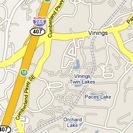





Atlanta Skyline looking SE from a ridge in Vinings
across 2 or 3 intervening parallel ridges
Parallel Ridges in the Brevard Zone
On a shaded relief map, many segments of the Brevard Zone show rythmically spaced parallel ridges, oriented along the Zone’s northeast strike. These ridges are responsible for the Chattahoochee River’s northeast to southwest course through north Georgia; they intercept drainage that would otherwise flow southeast toward the Atlantic Ocean, diverting it southwest toward the Gulf of Mexico. In northwest Atlanta, the Chattahoochee breaks through these ridges, probably by following these sets of joints ( fractures ) in the ridge rock.
The Gold Belt and the Murphy Belt show similar sets of parallel ridges, suggesting structural similarity among these features.

Historical Marker
The Errant Pontoon Bridge Located on Paces Ferry Rd. just West Chattahoochee River Bridge
July 5, 1864, during Johnston's retreat from Smyrna, a portion of his wagon train detoured from the Atlanta- Marietta Rd. via Vinings Station to a pontoon bridge at Pace's Ferry. Wheeler's Calvary escorted the trains; when all were across, the bridge was cut loose so as to swing down stream to the Fulton Co. side. Federal gun fire, preventing it's removal, the bridge was cut loose by the Confederates, but instead of floating down to shelter within Johnston's River Line at Bolton, it lodged on it's side where it was seized by troops of Hazen's 4 A. C. Brigade, July 8, 1864.



Early on, Vinings was known as Crossroads, and then Paces, after Hardy Pace around 1830. He operated Pace’s Ferry across the Chattahoochee River, in this area between Atlanta, Buckhead and Smyrna. Paces Ferry Road is still the main east/west road through town. The Western & Atlantic Railroad laid rail tracks from Atlanta, northwest to Chattanooga in the 1840s. Vinings became a construction station for the railroad, and was inadvertently named for William H. Vining as he worked on the railroad construction of "Vinings Bridge" laying tracks in the area. The railroad is still state-owned as it was from the beginning, and is now leased to CXS.
The United States Army occupied the Vinings area during the Atlanta Campaign of the American Civil War in 1864 on his March to the Sea. Unfortunately, Pace's home which had been used as a hospital for Union troops was destroyed in the process. Vinings recovered after the war as Governor Brown leased the railroad to Vinings to bring passengers to the springs and pavilions built to encourage a respite from the reconstruction of Atlanta. Vinings was officially recognized as a community in 1904, the same year the one-lane bridge was constructed across the Chattahoochee River. The town was never incorporated, though it had been discussed whether it should become a township.
Hardy Pace moved his post office here from Paces Ferry in 1839 and called Crossroads. The early post office of Vinings Station was established here in Oct. 1868. It was named for one of the civil engineers who laid track for the Western and Atlantic railroad. Vinings Mountain nearby had previously been called Pace's Mountain after Pace had built a home at it's base.
The Battle of Pace's Ferry was an engagement fought on July 5, 1864, near Atlanta during the Civil War. Union troops of Maj. Gen. Oliver O. Howard seized a key pontoon bridge over the Chattahoochee River. enabling Federal troops to continue their offensive to capture the important rail and supply center of Atlanta.
William T. Sherman's army had steadily advanced towards Atlanta in the spring and summer of 1864, fighting a series of battles against the Confederate Army of Joseph E. Johnston. Sherman continually flanked the Confederate positions and slipped ever closeward to his goal. Howard's IV Corps pursued the retreating Confederates along the Western & Atlantia Railroad, with General Thomas J. Wood's brigade in the lead. They encountered very little skirmishing until the head of column reached Vinings Station. From that point, a road led to the east toward Atlanta, crossing the Chattahoochee River at Pace’s Ferry, where the Confederates had constructed a pontoon bridge over the swift flowing deep river. Wood's skirmishers encountered a brigade of dismounted cavalry, which had its front covered by rail barricades along a ridge at right angles to the road, a quarter mile from the railroad station. Wood quickly drove the Confederates from these barricades and pushed on to the river. Despite Confederate efforts to destroy the bridge to prevent it from falling into enemy hands, Wood's men arrived in time to save a greater part of the bridge. Confederate attempts to burn the structure had failed, and mooring ropes had been cut on the Confederate side so that the pontoon bridge drifted in the river.
Not seeing a suitable opportunity to attack the strong Confederate positions across the Chattahoochee, Howard ordered his corps into camp on high ground facing the river and awaited the arrival of Federal pontoons. When they arrived on July 8, he crossed the river and outflanked the Pace's Ferry defenders, forcing them to withdraw.

